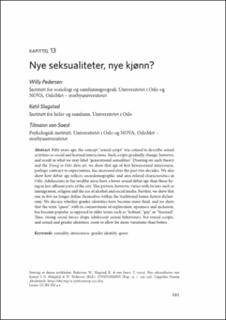Nye seksualiteter, nye kjønn?
Chapter, Peer reviewed
Published version
Permanent lenke
https://hdl.handle.net/11250/2838551Utgivelsesdato
2021-11-18Metadata
Vis full innførselSamlinger
Originalversjon
https://doi.org/10.23865/noasp.142Sammendrag
Fifty years ago, the concept “sexual script” was coined to describe sexual activities as social and learned interactions. Such scripts gradually change, however, and result in what we may label “generational sexualities”. Drawing on such theory and the Young in Oslo data set, we show that age of first heterosexual intercourse, perhaps contrary to expectations, has increased over the past two decades. We also show how debut age reflects sociodemographic and area-related characteristics in Oslo: Adolescents in the wealthy areas have a lower sexual debut age than those living in less affluent parts of the city. This pattern, however, varies with factors such as immigration, religion and the use of alcohol and social media. Further, we show that one in five no longer define themselves within the traditional homo-hetero dichotomy. We discuss whether gender identities have become more fluid, and we show that the term “queer”, with its connotations of exploration, openness and inclusion, has become popular, as opposed to older terms such as “lesbian”, “gay” or “bisexual”. Thus, strong social forces shape adolescent sexual behaviours, but sexual scripts, and sexual and gender identities, seem to allow for more variations than before.

